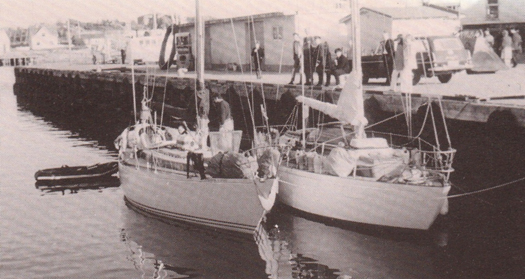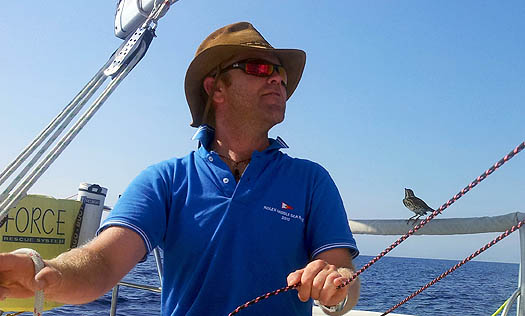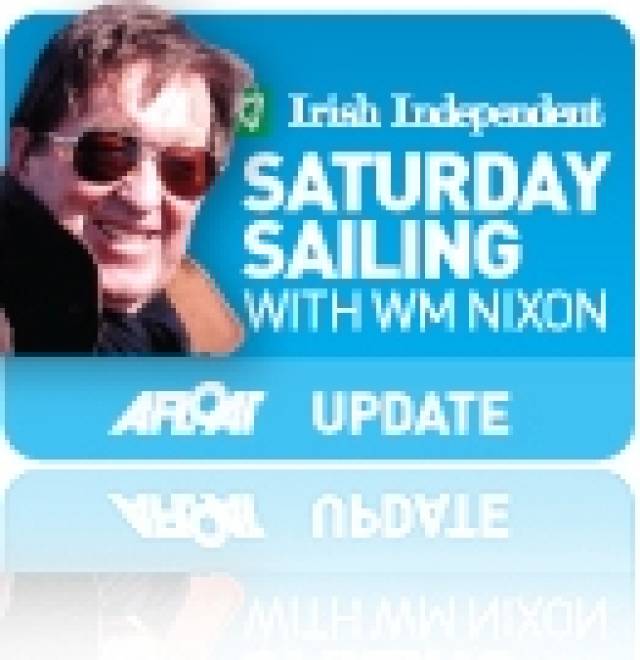#sywoc – An all-Ireland squad represents us in the Student Yachting Worlds getting under way in La Rochelle in France with the practice race today, the team drawn from Sligo, Mayo, Belfast, Wicklow, Dublin, Cork and Antrim.
At the end of an international season which has seen some of our best-known sailing stars hit the heights only to miss the podium at the very end, the amount of hope which is being invested by the Irish sailing community in the national college team is unreal. But that's the way it is at this level of sailing, and in their season-long buildup to the big event in the Bay of Biscay, the team of ten have been getting every sort of encouragement, advice, training and assessment from the best sources available.
The French started this series back in 1979, and it has been gradually growing in stature ever since. It's their baby, so it's their own affair if they persist in calling it a "yachting" event. But everywhere else has long since thought of our sport as sailing, so it's pure Gallic pig-headedness to persist with the clunky yachting tag, particularly for a series which highlights the sailing stars of the future.
The teams are provided by the winners of each country's national intrcollegiate championship, and way back in 1988 Trinity, after winning the Irish title, went on to become the first Irish world champions. This year, UCD did the business on the home front back in March by winning the Irish title in Dun Laoghaire, breaking a long and successful stranglehold by CIT.
The Cork sailors had a great run of it in the Worlds, with second in 2007, first in 2009 when Nin O'Leary was skipper, fourth in 2009, and a remarkable third in 2011 with George Kenefick the skipper –it was remarkable as the draw had given CIT one of three boats that were definitely not up to standard.
UCD are captained by Cathal Leigh-Doyle from Ballincar in Sligo, while the crew skipper is Aidan McLaverty. Others in the lineup are Barry McCartin (tactician), Ben Fusco, Simon Doran, Theo Murphy, David Fitzgerald, Ellen Cahill, Isabella Morehead and Alyson Rumball.
In addition to supervised workouts in UCD's performance gym, they've been intensively training afloat under the watchful eye of Nin O'Leary, John Downey, Marty O'Leary and Maurice "Prof" O'Connell. And Olympic helm Annalise Murphy, who was contemporary at UCD with many of the crew in First Year, but took time out for her sailing challenge, has been getting together with them in support.
Racing is from tomorrow through November 3rd. It's a fleet event with 14 national teams including the US, Canada and Australia, with France's Euromed team the defenders. The programme includes inshore, offshore and coastal races, and early indications are of lightish north to northeast breezes in the racing area. But a lot can happen weatherwise in the last week of October, and we can be sure many Irish sailing fans will be closely watching meteorological movements off La Rochelle for the next seven days.
GILDED YOUTHS BECOME GOLDEN OLDIES

The Dun Laoghaire boats Clarion and Felise in Svolvaer in northern Norway in 1970, crewed almost exclusively by young sailors recruited through the university sailing clubs in Dublin
Encouraging the university sailing scene is a demanding business, as the turnover in talent is so rapid. The notion of the desirability or otherwise of three years degree courses is sensibly being challenged by the Slow Learning Movement. This informal international grouping hastens to tell us it's not about slow learners as popularly perceived, but is about tailoring and shaping courses and the time allotted to suit individual needs.
It's a decidedly luxurious ambition for sure, and hardly a runner in a time of economic recession, even if a popular way of passing the time before the financial wheels begin to turn again is to find some college offering post-grad courses with student support grants.
Nevertheless, even with four year courses, plus the addition of post-grad input, no sooner does a college sailing club begin to get a winning squad together than they've either graduated or been sent down. Sometimes a winning team finds itself so seriously and suddenly de-populated that truly creative solutions have to be found to define just who is or is not a student, and at what college.
It's only a matter of time before they offer degree courses in dealing with the challenge of keeping college teams up to strength and together. American universities are way ahead of the curve with their sports scholarships and many other sorts of imaginative funding. But it's not generally realized that, back in the day, Dun Laoghaire was a world leader in encouraging university sailing.
This happy state of affairs developed as the Irish Dinghy Racing Association grew in strength in the late 1940s and through the 1950s. The Firefly class was at the core of dinghy sailing in Dublin Bay, and the three waterfront clubs were in a dynamic interaction with UCD, TCD and RCSI.
For those of us from universities less favourably set up in their sailing, it was a real revelation to come to Dun Laoghaire and find UCD well placed with the National YC, Trinity in comfort at the Royal St George, and College of Surgeons in situ at the Royal Irish.
The system worked very well. All the Dublin-based university sailing teams were in the front rank of top level competition with British colleges, the only international competition available in those days. And student life being more leisurely in those days, the undergraduates added significantly to numbers competing at summer events like Dinghy Week.
The arrangement was of course a matter of enlightened self-interest by the powers that be, as it introduced each waterfront club's senior sailing members to young and energetic potential crewmen and crewwomen. There's many a golden oldie offshore racing or cruising skipper about Dublin Bay these days who got his or her first taste of big boat sailing thanks to the introductory services indirectly provided though having university sailing clubs using the big clubs' premises.
The system reached a high point in 1970 when two Irish cruising boats met up in Svolvaer in the Lofoten Islands off the far north of Norway. The locals were very impressed – they said it was the first time two sailing craft had been together in the harbour in fifty years, for this was long before the Arctic's current popularity as a cruising destination.
One of the boats was the 13-ton sloop Felise, owned by Ninian Falkiner, Commodore of the Royal Irish. The other was the 43ft Clarion of Wight, owned by Rory O'Hanlon, Commodore of the Royal St George. And in both cases, their crews were made up almost entireely of young sailor recruited through the university sailing clubs.
BIRDS ON BOARD

Barry Hurley en route to winning the double handed class of the Middle Sea Race this week
By the time this is on the screen, we'll know how Barry Hurley and Andrew Boyle finished in the two-handed division in the Middle Sea Race. (It's a win! - Ed) But meanwhile everyone visiting the Afloat.ie website recently has been enchanted by the photo of Barry sailing along in the race, and getting every encouragement from a visiting sparrow beside him, perched on the guard rail.
Of course it's not natural, it's not what sparrows would like to be doing, but inevitably we empathise with the little thing, and wonder what's going on in that particular bird brain. Inevitably, the assumption is that it will end unhappily - the bird must have been exhausted to take up such an unlikely perch in the first place. But such stories can sometimes have a happy ending.
Many years ago we were returning from the Isles of Scilly towards the Tuskar after an early-season cruise to Northwest Spain. It was mid-June, so migratory birds were still heading northwards, but even so it was a matter of wonder as we sailed along that a swallow found its way through the companionway and into the saloon.
My shipmate Davy McBride is one of those people with an easy affinity with wildlife, and instinctively he held up his arm and the swallow settled on it, very much at ease. The little bird eventually found a temporary nest under the sprayhood beside the warmth coming through the companionway.
We made our landfall on track, but were quite close to the Wexford coast before that evocative aroma of the land came out to us – as they say in Irish Lights when they have favourable conditions for working at buoys and other navigational aids, "the wind was off the grass".
Our little passenger, who had taken some drinking water, bestirred himself, fluffed out his feathers, and then took off with a cheerful chirrup. He didn't fly immediately to the nearby land, but did a couple of circuits of the boat before taking his departure towards Wexford. We remember that so clearly, years after supposedly more important details of the cruise to Galicia have long since faded away.































































